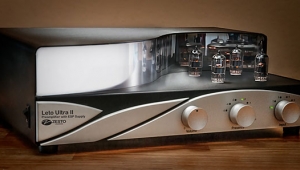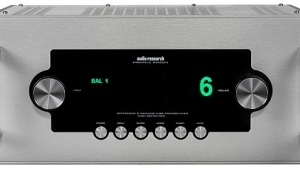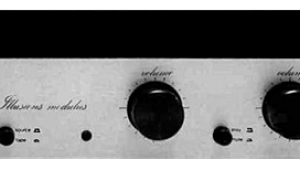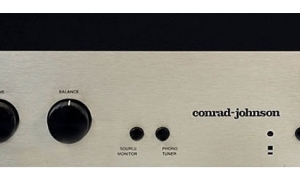| Columns Retired Columns & Blogs |
Convergent Audio Technology SL1 Renaissance preamplifier Black Path Edition
Convergent Audio Technology SL1 Renaissance Black Path Edition preamplifier, from December 2015 (Vol.38 No.12)
Footnote 1: Convergent Audio Technology, 85 High Tech Drive, Rush, NY 14543. Tel: (585) 359-2700. E-mail: catamps@aol.com.
Known simply as "the CAT," Convergent Audio Technology's SL1 tubed preamplifier first appeared in 1985, and ever since has been the subject of almost continuous improvement (footnote 1). According to Ken Stevens, founder and chief designer of Convergent Audio Technology, some of those improvements—use of a specific wire, tweaking the value of a certain resistor, a minor change in wiring layout, etc.—used to be incorporated into production with no change in model name, and with little or no increase in retail price. When enough such changes have accumulated and/or have amounted to significant cost, a new model is designated—Reference, Reference Mk.II, Signature, Signature Mk. II, etc.—and the price increased. Whenever possible, CAT made available upgrades of earlier models, but sometimes the changes were so extensive that upgrading isn't cost-effective—ie, the upgrade would cost almost as much as a new SL1. Nonetheless, earlier versions of the SL1 are much in demand on the used market.
This policy changed with the SL1 Renaissance, which I reviewed in the November 2009 issue, was itself the result of upgrades that couldn't easily be applied to earlier units. Those changes were extensive, including new circuit-board material and layout; an improvement in the power supply; switch-selectable gain; an A/V Bypass; and an optional built-in moving-coil transformer. As I said in my review, while the Renaissance's predecessor, the SL1 Ultimate, was an excellent preamp, the Renaissance was comfortably ahead of it in every musically relevant parameter. I then posed the somewhat rhetorical question: "Has every aspect of the design and its execution been tweaked to the point at which no further improvement is possible?" My not-so-rhetorical answer: "For now, the answer has to be 'Yes.' As for the future—well, knowing Ken Stevens, I wouldn't bet on it."
Six years later, I'm glad I didn't.
What's New, Pussycat? The SL1 Renaissance Black Path Edition is named for CAT's new Black Path capacitor, which is used in the most critical positions in the preamp. As Ken Stevens tells the story, every three or four years, CAT holds a "capacitor shoot-out" (see sidebar). In previous shoot-outs, the CAT cap, designed in 1990 by Stevens, emerged unscathed. However, at the last shoot-out, one of the other capacitors had a more natural-sounding midrange, and another had better low-level resolution. But both had shortcomings in other areas, so Stevens designed a new cap: the Black Path. According to Brian Wasserman, who handles customer relations for CAT, "the Black Path capacitor utilizes a film with a highly convoluted arrangement of the long-chain molecules. This greatly slows down the absorption rate of fast moving signals (ie, those at 2Hz or above) and then slows down the re-release of energy back into the signal."
While designing the Black Path capacitor, Stevens and his crew were also working on the new "baby CAT" power amplifier, the JL5. The process resulted in many new findings regarding power-supply design, audio-circuit optimization, and ultimately, reduction of noise intermodulation. According to Stevens, all of these enhancements, which are now incorporated into the SL1 Renaissance Black Path Edition, are cumulatively more significant than the Black Path cap itself.
The SL1 Renaissance Black Path Edition costs $11,990 with phono stage, $9990 without. The price of the Renaissance with phono had held steady at $9995 for eight years, so the increase just about covers inflation. An SL1 Renaissance with phono can be upgraded to Black Path status for $4000 (the upgrade for the line-only version is $2500). Earlier versions can't be upgraded.
Options: The Black Path Edition can also be had with some interesting options—above and beyond the upgrades described above, in both scope and cost—that were unavailable in earlier SL1s. Like all previous versions, the Black Path is a single-ended design, but Ken Stevens has endeavored to make it work well with balanced source components and amplifiers. In the past, this involved plug-in adapters, but now XLR inputs are available at no extra charge. According to Ken Stevens, when the negative leg of a source component's balanced output is generated by an op-amp—which he suggests is usually the case—that portion of the signal is best ignored, as it will be by CAT's newly available pseudo-balanced XLR inputs. The Black Path Edition is also available with true balanced outputs, the negative legs of which are derived from the signal by transformers described by Stevens as excellent—but pricey: This $2000 option, not included in my sample, is recommended for use with balanced amplifiers of low common-mode rejection ratio, which produce less power and more distortion if they aren't provided an antiphase signal.
A second option addresses a long-standing request from SL1 owners—and a long-standing criticism from reviewers: The 23-step volume control used in all previous SL1s was limited, in the middle of its range, to steps of 2.5–3.0dB. This sometimes led to a situation where the desired playback level was unattainable, existing as it did between two selectable levels. CAT's optional 46-step volume control is most welcome, providing increments about half the size of the standard control. At $1000 it's fairly expensive, but it's a high-quality component, its installation is labor-intensive, and Stevens claims that it sounds better. It was installed in the upgrade of my Renaissance to the Black Path Edition, and I found the finer volume gradation very useful.
Listening: It's only logical: The better an audio component, the less room for improvement. The CAT SL1 Renaissance was already an excellent preamp, so when Ken Stevens told me that an upgrade was available, I assumed that any sonic improvement would likely be modest.
I was wrong. Within a few minutes of listening to my SL1 Renaissance Black Path Edition, I knew I was hearing no minor improvement—an impression that solidified as the preamp continued to warm up and break in. My original plan had been to discuss the upgrade in a short sidebar to a review of a different product; having now heard the improvements, I felt they deserved a separate Follow-Up. Except as noted below, I played CDs through PS Audio's PerfectWave MemoryPlayer transport and PerfectWave DirectStream DAC. The speakers were Avantgarde Acoustic Uno Nanos, driven by a McIntosh MC275LE amplifier. All cables were Nordost Valhalla 2.
In my review of the PS Audio DirectStream DAC in the February 2015 issue, I compared driving the McIntosh MC275LE directly from the DirectStream's analog outputs vs through the CAT SL1 Renaissance, at matched levels. The DirectStream's operating system was the then-current v.1.2.1. My preference was for the signal played through the SL1 Renaissance—but, as I noted in the review, it was a close call: I had to switch back and forth at least a half-dozen times before I was confident in my conclusion.
I made the same comparison with the Black Path Edition (the DirectStream itself having been upgraded to the latest—and sonically superior—Yale OS). This time there was no contest: Through the Black Path, music was simply more open, with more clearly defined soundstages and a more dynamic presentation. Nor did I have to do much switching back and forth to arrive at this conclusion—the differences were immediately apparent.
I had already listened a couple of times to Eugene Istomin's recording of Mozart's Piano Concerto 21, with Gerard Schwarz conducting the Seattle Symphony Orchestra (CD, Reference RR-68CD), and while I thought its sound was excellent, the interpretation seemed a bit bland and lacking in energy. Listening to it through the Black Path Edition, I noticed a lot more in the way of subtle dynamic variation, with no lack of energy when that was called for, and with a most effective communication of the playful interplay between piano and orchestra. Admittedly, other variables were in play—my audio system had undergone some changes since the last time I'd listened to this recording—but when I bypassed the Black Path using the DirectStream's variable analog output, some of the subtle dynamic variations were obscured. The Black Path Edition had a special way with dynamics, revealing variations at both the subtle and extreme ends of the range.
A related factor, particularly evident in recordings of piano and of other percussion instruments, was the Black Path's rendering of intertransient silence. Percussive sounds generally seemed crisper—not sharper or exaggerated, but with less overhang of notes. Listening to Dick Hyman Plays Fats Waller (direct to CD, Reference RR-33DCD), I'd always been impressed with Hyman's technique; through the Black Path, his fingers seemed to fly even more effortlessly, or as if the action of his Bösendorfer 2905E reproducing piano had been tweaked for faster response. Quite remarkable.
Going through my audiophile checklist, all the important characteristics were improved: Soundstages were more clearly defined, with better focus on voices and instruments; tonal balances were as neutral as could be, with no warmth added or subtracted, or other departures from neutrality; trebles were extended but sweet; and bass was similarly extended and very natural in character. Noise, which can be a problem with tubed equipment, was simply absent in practical terms: With the volume control set to a normal listening level but without applying signal, I engaged and disengaged the Mute control and had to strain to hear any difference at all.
In my write-up of the SL1 Renaissance, I described it as having the much-desired combination of high transparency and high resolution. By transparency I mean a component's ability to get out of the way of the music, adding as little as possible of its own characteristic sound or coloration. By resolution I mean a component's ability to reveal the most minute recorded details. Although I didn't have a non-upgraded SL1 Renaissance on hand for an A/B comparison (and don't forget those other changes to my system), I'm comfortable in saying that the Black Path Edition further enhanced the SL1 Renaissance's transparency and resolution.
Ken Stevens is justifiably proud of the Black Path Edition's phono section ("Make sure you listen to some LPs," he told me). It was extremely quiet, and its switchable MC transformers and plug-in load resistors allow it to be optimized for use with a wide range of cartridges. In my 2009 review, I'd noted that the SL1 Renaissance's phono section was much quieter than that of the preceding model, the SL1 Ultimate. Not having the SL1 Renaissance and Black Path Edition available at the same time for a direct comparison, I'm reluctant to say that the latter sounded "much better," but it certainly sounded as good. My phono source consists of an aging Linn LP12 turntable with Ittok VII tonearm, and a similarly aging AudioQuest AQ7000nsx cartridge—a combination that, while very listenable, falls well short of the state of the art. I'm in the middle of upgrading to a new turntable, arm, and cartridge, but that will be a story for another day. My experience with the Black Path Edition told me that it will be easy to set it up to match my new cartridge, and that the SL1 will not be a limiting factor in optimizing the sound quality.
Conclusions: Convergent Audio Technology's SL1 Renaissance Black Path Edition is a preamplifier that can be described only with superlatives. It is simply a great preamp, and represents a major improvement on its predecessor, the SL1 Renaissance. But more than any of the specific component changes, such as the use of CAT's Black Path capacitor, the factor most responsible for the performance of the Black Path Edition is designer Ken Stevens's single-minded devotion to making his products the best they can be by selecting the best-sounding components and tweaking every aspect of the design for optimal sound quality.
Of course, a preamplifier is only one component of an audio system; at the risk of stating the self-evident, it can't, by itself, produce sound. Every component of an audio system is important, and the first link in the chain is the recording itself. But if everything else in the system is working right, the SL1 Renaissance Black Path Edition will get you closer to the music's soul.—Robert Deutsch
Footnote 1: Convergent Audio Technology, 85 High Tech Drive, Rush, NY 14543. Tel: (585) 359-2700. E-mail: catamps@aol.com.
- Log in or register to post comments




































